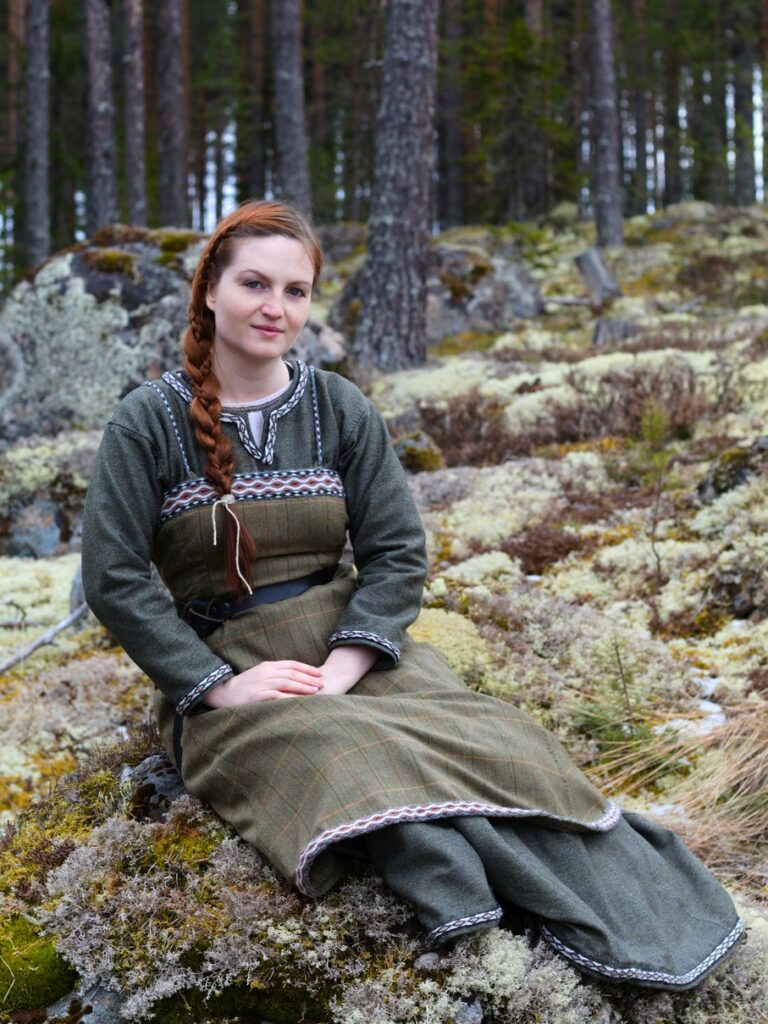In contrast to later styles of dress I present on this page, we do not have complete garments preserved from the Viking age. Most pieces of fabric are leftover from graves or the port of Haithabu, where they were used as racks (Hägg, 1984). For example, one of the largest pieces found there has the measurement of a modern piece of paper. Therefore, it is hard to determine the exact shape and patterns of the fashion they were part of. As a consequence, my dresses have to be seen as one option of interpretation. They are based upon the excavation reports of Haithabu and various other primary and secondary sources, for example the graves at Birka, that Inga Hägg sum up in 2015 in a German book, which is my main reference (see further reading below).

Since they were often used by several people before wearing out (Hägg, 2015, S. 170f.), and were considered very expensive, I try not to waste any leftover pieces of fabric and alter my dresses a lot. By the way, the garments were dyed with natural fibers and ingredients. This was expensive and mainly used by upper class people (2015, S. 171f.). However, I only tried this out once. The majority of my fabric is simply dyed with chemical substances during production. Historically, fabric was weaved by hand on a vertical loom. Of course, I cannot keep up to this standard. Various techniques were used, so that the fabric had a lot of different textures (Hägg, 2015, S. 123, 126 u. 131). Wool and linen were the most common fibers, the latter one beeing imported and therefore expensive (Hägg, 2015, S. 119 u. 122). Fragments of silk were found as well (Hägg, 2015, S. 115 u. 175). Further, we do not know if hide was used commonly, so I try to avoid it. However, rich fur was used for decorative elements, or even immitatet by those who could not afford it (Hägg, 2015, S. 171). Hägg suggests that the burial clothing must have been exceptional rich garmants, so that it is not a direct window to daily wear (Hägg, 2015, S. 138 u. 168). Economic status was not shown on the base of a special pattern or type of garment, but by the fibers and quality of fabric (Hägg, 2015. S. 170f.).
When cutting the fabric, near to zero is wasted due to the simple pattern pieces I design. All garments had to be sewn by hand. I mainly use linen thread. To be honest, I do not know if the thread was dyed, too, but often use the matching color anyway.

More about female clothing can be read on a separate page.
Another one deals with outer garments.
Literature (German):
– Hägg, Inga: Die Textilfunde aus dem Hafen von Haithabu, (Berichte über die Ausgrabungen in Haithabu, hrsg. v. Archäologisches Landesmuseum der Christian-Albrechts-Universität), 1984.
– Hägg, Inga: Die Textilfunde aus der Siedlung und aus den Gräbern von Haithabu. Beschreibung und Gliederung, (Berichte über die Ausgrabungen in Haithabu, hrsg. v. Archäologisches Landesmuseum der Christian-Albrechts-Universität), 1991.
– Hägg, Inga: Textilien und Tracht in Haithabu und Schleswig, 2015.
– Groenman-van Waateringe, Willy: Die Lederfunde von Haithabu, (Berichte über die Ausgrabungen in Haithabu, hrsg. v. Archäologisches Landesmuseum der Christian-Albrechts-Universität), 1984.
– Textile Research Centre Leiden (I): Viking Embroidery, online at: https://trc-leiden.nl/trc-needles/regional-traditions/europe-and-north-america/embroideries/viking-embroidery [Last update 2016, last viewed on 27th June 2020, 12:15 Uhr].
– Textile Research Centre Leiden (II): Oseberg Ship Burial (Norway), online at: https://trc-leiden.nl/trc-needles/individual-textiles-and-textile-types/fragments-and-panels/oseberg-ship-burial-norway [Last update 2016, last viewed on 27th June 2020, 12:15 Uhr].
– For drawings of oval brooches: The Viking Age Compendium: Brooches – Viking Paired Styles, online at http://www.vikingage.org/wiki/wiki/Brooches_-_Viking_Paired_Styles [Last viewed on 27th June 2020, 12:50 Uhr].